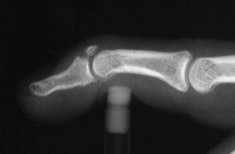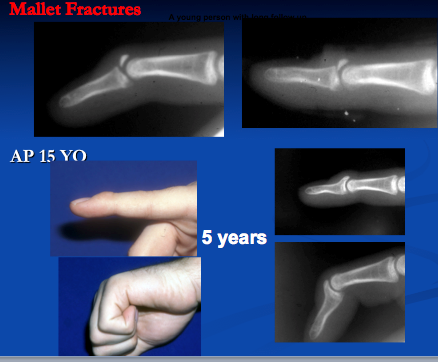Mallet Fractures: Non-Operative Management
By Lawrence H. Schneider, MD

This is a tiny fracture that occurs at the dorsal base of the distal phalanx. The long extensor tendon remains attached to the bony fragment. The injury has piqued the interest of hand surgeons and there are a large number of papers in the hand surgery literature out of proportion, I believe, to its significance. Many of these papers are devoted to various surgical approaches some clever and some not. A recent review of the literature (1) does an excellent job of sorting out 62 articles on mallet finger. I warn the reader that some authors group mallet fractures and soft tissue mallet fingers together but they present different issues and should be dealt with separately.
In the past we have been TOLD that when a closed mallet fracture presents:
IF the bony fragment occupies more than 1/3 of the joint surface (Fig.1)
OR the fragment remains displaced after the finger is straightened (Fig. 2)
OR the joint has subluxated volarly (Fig.3), then surgical management is indicated.
In 1984 Dr. Marwan Wehbe and I (2) reviewed my experience with these injuries and we concluded that they could be treated non-operatively with simple splinting. We saw that the base of the distal phalanx, when fractured, had a remarkable ability to remodel and will preserve the joint space. We thought that we had made a case for non-operative treatment.
Since 1984, hand surgery literature has been besieged with papers advocating surgical methods of treatment. These include open reduction and pin fixation and variations of dorsal blocking pin techniques done using percutaneous pins. Published papers also suggested:
- Transection the extensor tendon to better expose the bony fragment
- Three mini screws in the fragment (WOW!)
- Plates and screws
- Tension band wiring
- A report (3) identifies what is described as a newly discovered double level mallet injury where at the time of injury the extensor tendon is also separated from the bony fragment thereby demanding open treatment.
In my opinion, (4) (5) (6) closed mallet fractures can all be treated in a splint or finger cast. The base of the distal phalanx will remodel. In closed mallet fractures, uninterrupted splinting of the DIP joint in extension for 6 to 8 weeks is recommended.
I have enjoyed sparring with colleagues like Bill Engber (7, 8) over the decades. Also a high-five to David Kalinov et al (9) and John Lubahn (10), who have offered support for non-operative treatment.
References
- Lin JS, Samora JB. Surgical and nonsurgical management of mallet fingers: a systematic review. J Hand Surg Am. 2018;43(2):146-163.
- Wehbe M, Schneider LH. Mallet fractures. J Bone Joint Surg Am. 1984;66A(5):658-669.
- Zhang X, Shao X, Huang Y. Pullout wire fixation together with distal interphalangeal joint Kirschner wire stabilization for acute combined tendon and bone (double level) mallet finger injury. J Hand Surg Am. 2015;40(2):363-367.
- Brzezienski MF, Schneider LH. Extensor tendon injuries at the DIP joint. Hand Clin. 1995;11(3).
- Schneider LH. Fractures of the distal phalanx. Hand Clin. 1988.
- Chen F, Schneider LH. Fractures of the distal phalanx. Oper Tech Orthop. 1997;7(2):107-115.
- Lange RH, Engber WD. Hyperextension mallet finger. Orthopedics. 1983;6:1426-1431.
- Damron TA, Engber WD, Lange RH. Biomechanical analysis of mallet finger fracture fixation techniques. J Hand Surg Am. 1993;18A:600-607.
- Kalainov DM, Hoepfner PE, Hartigan BJ, Carroll C 4th, Genuario J. Nonsurgical treatment of closed mallet finger fractures. J Hand Surg Am. 2005;30(3):581-586.
- Lubahn JD. Mallet finger fractures: a comparison of open and closed technique. J Hand Surg Am. 1989;14:394-396.
Fig. 1. Fragment >1/3 articular surface

Fig 2. Fragment displaced

Fig. 3 Joint subluxed

Comments (2)
alejandro Badia
May 10, 2018 11:14 pmHey Larry, I guess we didn’t spar enough!! You must have forgotten.
A paper written by a swiss surgeon, Luchina, in the Chinese literature compared three pinning techniques where the one i described to you came out slightly on top. However, virtually all patients avoided the persistent droop we often see, or worse, the tender bump that patients hate ( as in one of the pics you show). If its my finger,putting two perc pins including a shepard crook that PULLS the avulsed fragment to the trough has none of the complications you mention (3 screws-yikes is right) but avoids those issues and takes all of about 7 minutes.
https://www.jhandsurg.org/article/S0363-5023(04)00548-9/abstract
Incidentally, I dont really believe the 1/3 rule but more important is whether the fragment reduces significantly with full extension and i quickly check that via in-office fluoro. If it does, plaster molded finger cast which costs nothing and well tolerated by the skin, with no chance patient can remove (almost)
i think we need another 20 minutes at the bar !! I will look for you in Boston my friend, for round 3.,…
AJ Mencias
May 11, 2018 11:26 amI couldn’t agree more. These almost always remodel. If pinning is required, Hill Hastings taught me to perform a two pin technique that has ALWAYS worked.